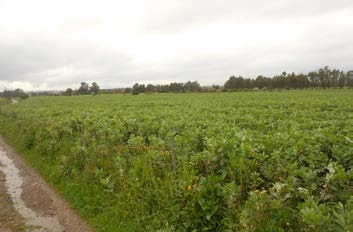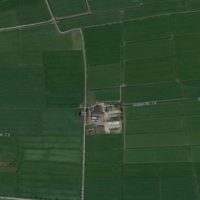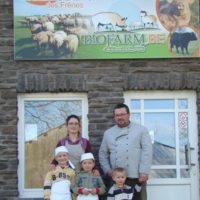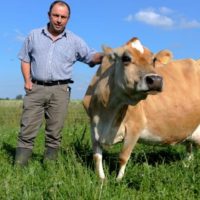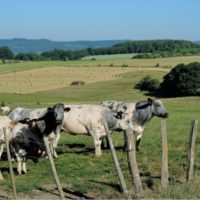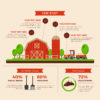Description
Background
Mr Littarru inherited his farm from his father. The farm (87 ha) is located in the South-West part of Sardinia (Italy). This sub-region is the most economically depressed area in Sardinia, so young people usual leave villages and emigrate abroad. Sheep breeding is one of the few job opportunities for people and the will of the farmer has always been to obtain a decent income for himself and his family. Unfortunately, several environmental and economic constraints greatly influence his farming activities. Farm soils are clayey, with sub-acid and acid pH, and suffer from waterlogging during the rainy season. The farmer can rely only on himself and on one seasonal worker also during periods of increased workload, because in the area there is a lack of agricultural seasonal workers. Finally, the farmer faces the unfavourable market for sheep milk.
Detailed description
To pursue his goals of higher income, the farmer decided to increase milk production, by breeding a more productive sheep breed, the Israelian Assaf sheep, in addition to the Sarda breed. He managed the two breeds separately, to make the most of the productive potential of the Assaf sheep (up to 430-480 l of milk per year), which have higher diet requirements than Sarda breed. For both breeds, he started to carry out the out-of-season mating to have milk production during summer, when regional milk prices rise. Moreover, the farmer introduced the cultivation of legumes, e.g. sulla, and the mixtures of clovers (Trifolium subterraneum) and sainfoin (Ornithopus sativus) with wheat or barley. In the mixtures with sainfoin, cereals were seeded at low seed rate. This strategy allowed the farmer to carry out soil tillage every two years. In fact, in the first year, both mixture component grew and sheep grazed. The grazing season stopped at the beginning of summer. With the first rains, serradella re-sprouted and could be grazed as a pure stand during the following autumn. The farmer adopted the same strategy for the first time also with sulla. Last year, due to the harsh drought during summer and autumn, both cultivations dried up and in the current year, the farmer did not repeated the cultivations and suspended out-of-season mating because he needed more time to family life to take care of his newborn son. Innovative crops will be re-established next year. Currently, he is cultivating:
- The complex mixture of T. michelianum, T. incarnatum, Lolium multiflorum, and L. multiflorum var. westervoldicum for grazing (10-15 ha),
- The simple mixture Lolium multiflorum – oat for hay production (35 ha), used especially in small paddocks for an easier management,
- And wheat, barley and oat in pure stands for grain and hay production (20 ha).
The soil tillage consists of shallow ripping, sod-breaking, and seeding+rolling carried out in a single passage. The farmers payed a particular attention to improve working conditions adopting strategies to reduce the time spent in agronomic practices. To do this, the farmer modified his precision seeder, so that it could be mounted in the frontal side of the tractor, while in the back side there is a heavy roller. In this way, he carried out seeding maintaining the roller always resting on the soil. Moreover, the seeder in the front of the tractor requires less power than a towed seeder, and this means saving fuel. The farmer fertilizes soils with diammonium phosphate before seeding pastures (150-200 kg/ha, for forage crops and cereals, respectively), incorporating the fertilisers in the soil during tillage and during pasture and cereals growth (140-160 kg ha-1 of ammonium nitrate). The farmer adopted a complex scheme of grazing management, based on paddocks of different sizes: 2 paddocks are 10 ha sized, 5 paddocks are 2.5 ha sized and 3 paddocks are 5 ha sized. The smaller paddocks are seeded with mixtures based on clovers and ryegrass (this mixture is easy to manage on small surfaces). Each of the smallest paddocks (2.5 ha) are grazed 6 times/month per 5 months, in average, in other words, each day sheep graze on a different small paddock. The wider paddocks are grazed daily, about 1-2 hours in the morning and 1-2 hours in the afternoon, for 5-20 days, depending on forage availability. After fertilisation, about 20 days are required to restore forage availability. Sheep diet is integrated with concentrates (brewers grains, beet pulp, soy flour) to boost milk production during summer, so that lactation in sheep is prolonged up to August (9 months instead of 6 months), also in absence of out-of-season lambing. Milk production is about 130,000-140,000 l per year, it is based on 360 heads of Sarda sheep, and 90 heads of Assaf breed. Milk is still being sold to dairies for cheese making.
Results
A higher income, an improved pasture production and quality and an improved life and work were the main results obtained from the adoption of mixtures based on serradella and sulla and the innovations concerning management. The introduction of legume-based mixtures allowed the farmer to increase the pasture availability and quality, an improved sheep health and lower costs for concentrates and lower use of fertilizer in the second year from establishment. The adoption of a second sheep breed with high productive performances allowed a higher yearly milk production and indirectly, a higher income, also if a higher workload was necessary when out-of-season lambing was carried out.
Adoption criteria
Other farmers can successfully introduce innovations of the Littarru farm. Concerning the breeding of the Assaf sheep, other farmers should be aware of the very different management of these breed compared to the Sarda sheep. In fact, dietary requirements of these sheep are higher than Sarda breed and if they are not met, milk production will be not different from Sarda sheep. Assaf sheep can be easily introduced also in other intensive or semi-extensive farming systems. The modification of the seeder is simple, and the combination with roller could allow farmers to save some fuel for seeding, because the needed for power is lower than other operational solutions. All agronomic situations where the use of heavy rollers are required could be suitable to the adoption of this innovation. The use of sulla or serradella mixtures is successful mainly to Mediterranean areas.
Future prospects
The farmer hopes to re-seed improve pastures based on sulla and serradella with the use of new varieties with higher drought tolerance. As alternative, he would like to have new species with similar features to seed. He would like also to use other fertilizer than the old diammonium phosphate, but the new fertilisers he tested are not efficient in the same way. Informal connections among farmers and the word of mouth could easily disseminate innovations to neighboring farmers.

